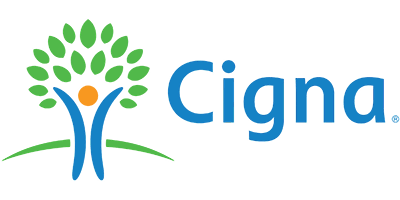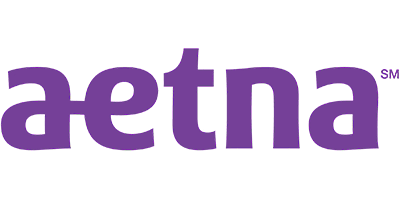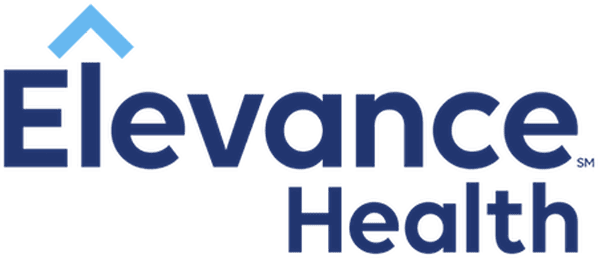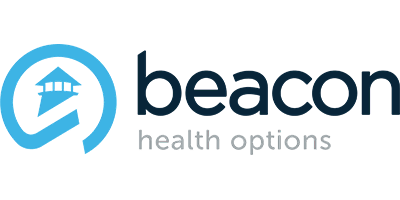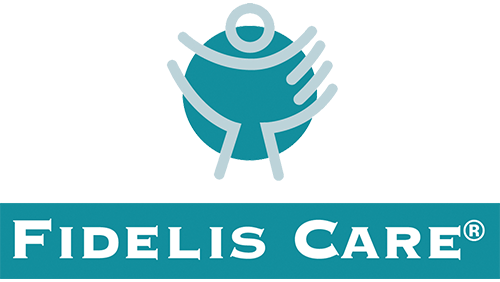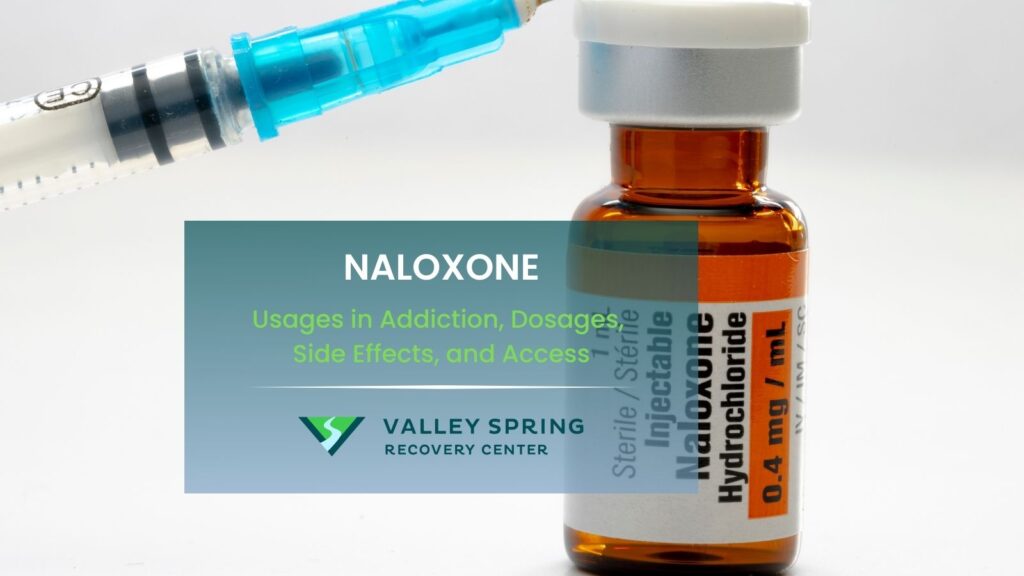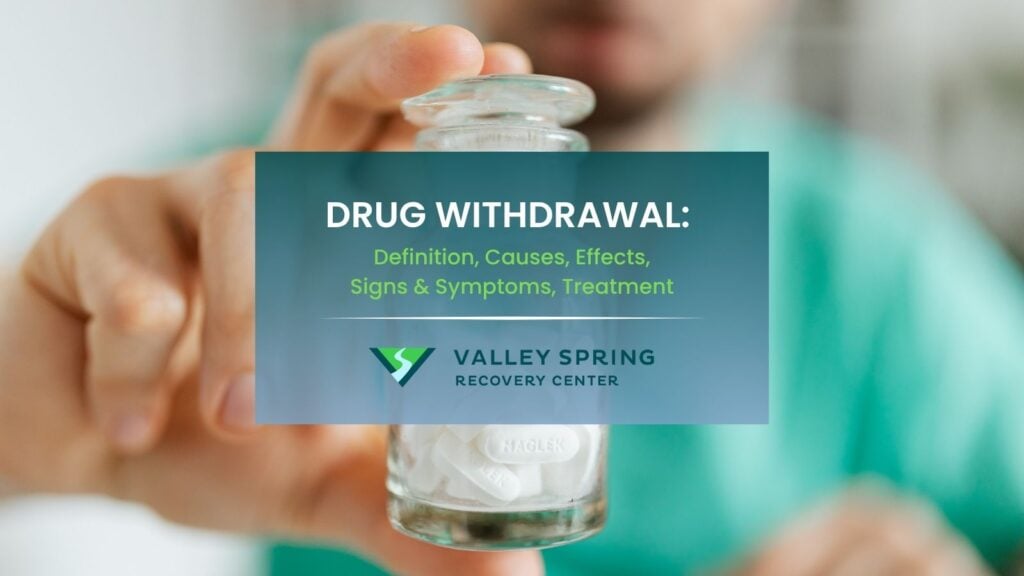15 Most Commonly Used Drug Addiction Screening Tests
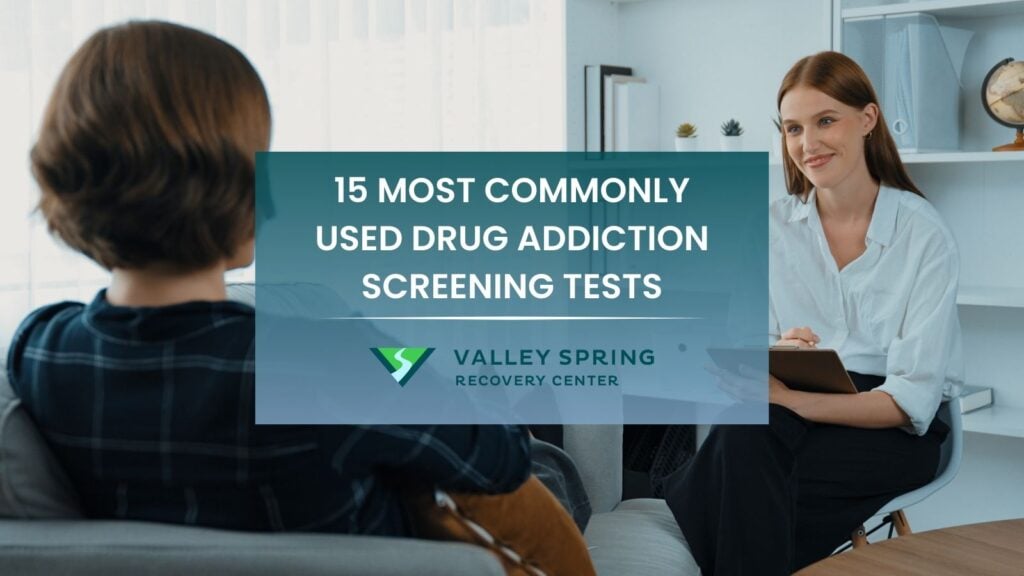
A drug addiction screening test is a tool used to identify people with substance use disorders. It involves questionnaires or interviews designed to assess drug use patterns and their impact on an individual’s life.
Drug addiction screening tests allow for early detection of substance use disorders, enabling timely intervention and treatment. They help improve treatment outcomes and reduce the health and social consequences of drug abuse.
Types of drug addiction screening tests include the Drug Abuse Screening Test (DAST), Alcohol Use Disorders Identification Test (AUDIT), CAGE Questionnaire, Screening, Brief Intervention, and Referral to Treatment (SBIRT), and saliva drug tests, among others.
Drug addiction screening tests are generally accurate but are not infallible. They should be used as part of a broader diagnostic process to ensure reliable results.
Drug addiction screening tests are available in primary care offices, hospitals, mental health clinics, and community health centers. They are also accessible through online resources and telehealth services.
What Is A Drug Addiction Screening Test?
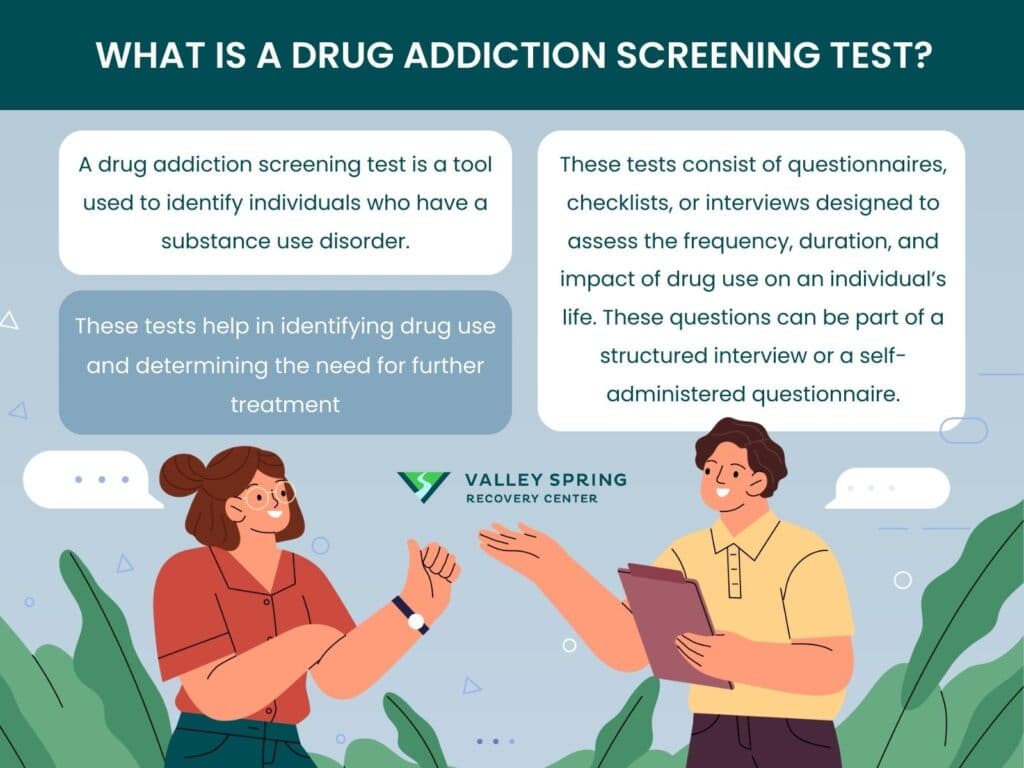
A drug addiction screening test is a tool used to identify individuals who have a substance use disorder. These tests consist of questionnaires, checklists, or interviews designed to assess the frequency, duration, and impact of drug use on an individual’s life. These questions can be part of a structured interview or a self-administered questionnaire. The responses are used to determine the presence and severity of a substance use disorder as defined in the DSM-5 and ASAM Criteria. MedlinePlus’s “Drug Use Screening Tests” (2023) notes that “These tests help in identifying drug use and determining the need for further treatment.”
Some screening tools are brief and can be completed in a few minutes, while others are more comprehensive and provide detailed information about an individual’s substance use history and related problems. They help determine whether someone requires further evaluation by a healthcare professional. According to the “Drug Abuse Screening Test” by Harvey A. Skinner, Journal of Substance Abuse, 1982.
Drug addiction screening tests offer numerous benefits, including early identification of substance use disorders, which lead to timely intervention and treatment. These tests help healthcare providers determine the level of care needed for individuals, improving overall treatment outcomes.
According to a research titled “Screening, Brief Intervention, and Referral to Treatment (SBIRT)” by the Substance Abuse and Mental Health Services Administration (SAMHSA), 2020, “SBIRT integrates screening and brief intervention, improving access to care and providing comprehensive management for substance use disorders.”
Early detection and intervention prevent the escalation of substance use and reduce associated health risks. According to a study titled “Drug Use Screening Tests” by MedlinePlus, 2023, “Early identification through screening tests allows for timely intervention, which can improve treatment outcomes.” A study titled “Screening, Brief Intervention, and Referral to Treatment (SBIRT)” by the Substance Abuse and Mental Health Services Administration (SAMHSA), 2020 states that “Early detection through screening allows for interventions that can mitigate the impact of substance use disorders on individuals and communities.”
These tests are administered in various settings, such as primary care offices, hospitals, and community health centers, making them accessible to a broader population.
Did you know most health insurance plans cover substance use disorder treatment? Check your coverage online now.
What Are The Types of Tests and Screenings for Substance Use Disorder?
There are various types of drug addiction screening tests, each designed to assess different areas of substance use. The 15 most commonly used drug addiction screening tests include:
- NIDA Drug Use Screening Tool
- Screening, Brief Intervention, and Referral to Treatment (SBIRT)
- CRAFFT Screening Test
- Breathalyzer Tests
- Alcohol Use Disorders Identification Test (AUDIT)
- Drug Abuse Screening Test (DAST)
- Michigan Alcohol Screening Test (MAST)
- CAGE Questionnaire
- Alcohol, Smoking, and Substance Involvement Screening Test (ASSIST)
- Saliva (Oral Fluid) Drug Test
- SASSI (Substance Abuse Subtle Screening Inventory)
- Posit (Problem Oriented Screening Instrument For Teenagers)
- SDS (Severity Of Dependence Scale)
- ASI (Addiction Severity Index)
- SUDDS (Substance Use Disorder Diagnostic Schedule)
1. NIDA Drug Use Screening Tool
The NIDA Drug Use Screening Tool is a comprehensive instrument developed by the National Institute on Drug Abuse (NIDA) to screen for substance use disorders. It is designed to be used in various healthcare settings to identify people who may have problematic drug use quickly.
This screening tool includes a series of standardized questions that assess the frequency and impact of drug use. It is structured to be easy to administer and interpret, making it suitable for use by healthcare professionals without specialized training in addiction medicine.
According to the National Institute on Drug Abuse’s 2023 study called “NIDA Screening Tools & Resources, “the NIDA Drug Use Screening Tool provides a structured and standardized approach to identifying drug use behaviors and their impact on individuals. “
The NIDA Drug Use Screening Tool is applied in various settings, including primary care offices, emergency departments, and community health centers. It is used to screen patients during routine health visits or when there is a suspicion of substance use.
The tool helps identify individuals who may need further evaluation or intervention. It facilitates early detection and intervention for substance use disorders. According to a 2020 study called “Screening, Brief Intervention, and Referral to Treatment (SBIRT)” by the Substance Abuse and Mental Health Services Administration (SAMHSA), “The application of structured screening tools like those developed by NIDA can enhance the identification and management of substance use disorders in primary care settings.”
2. Screening, Brief Intervention, and Referral to Treatment (SBIRT)
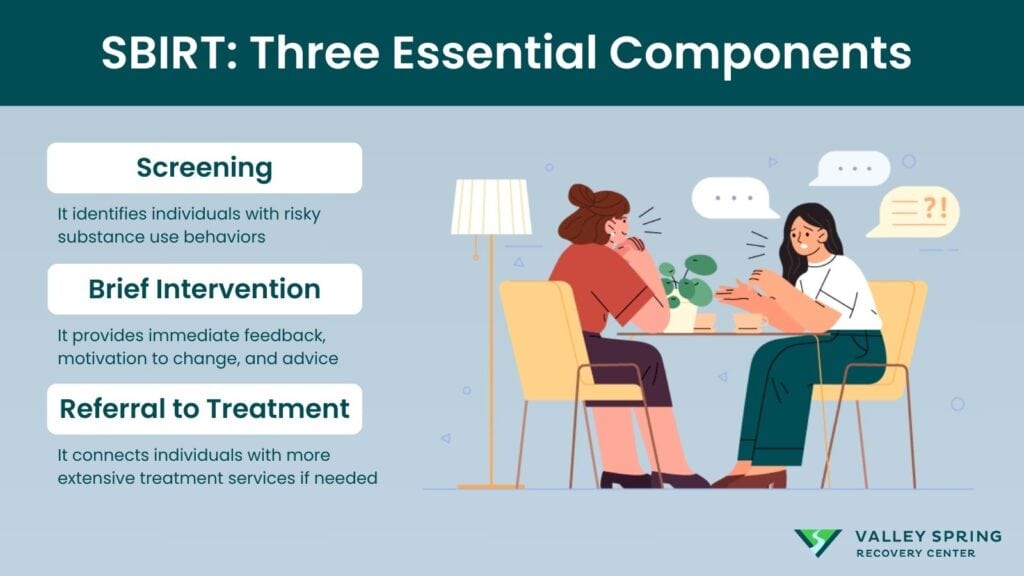
Screening, Brief Intervention, and Referral to Treatment (SBIRT) is an evidence-based approach used to identify, reduce, and prevent the use, abuse, and dependence on alcohol and drugs.
SBIRT consists of three components:
- Screening: it identifies individuals with risky substance use behaviors.
- Brief Intervention: it provides immediate feedback, motivation to change, and advice.
- Referral to Treatment: it connects individuals with more extensive treatment services if needed.
A 2020 study by the Substance Abuse and Mental Health Services Administration (SAMHSA) titled “Screening, Brief Intervention, and Referral to Treatment (SBIRT)” highlights that “SBIRT integrates screening and brief intervention with referral to treatment, providing a comprehensive approach to managing substance use disorders.”
SBIRT is typically implemented in healthcare settings such as primary care offices, hospitals, and emergency departments. It is designed to be easily integrated into routine medical care to enhance early detection and intervention.
According to the National Institute on Drug Abuse, 2023, “The application of SBIRT in healthcare settings facilitates early identification and intervention for substance use disorders.”
Research has demonstrated the efficacy of SBIRT model in reducing alcohol and drug use, improving health outcomes, and reducing healthcare costs. Studies show that SBIRT can effectively reduce the severity of substance use and related problems.
According to the study “Screening, Brief Intervention, and Referral to Treatment (SBIRT)” by the Substance Abuse and Mental Health Services Administration (SAMHSA), 2020, “SBIRT has been shown to be effective in reducing substance use and improving health outcomes.”
Contact us today to schedule an initial assessment or to learn more about our services. Whether you are seeking intensive outpatient care or simply need guidance on your drug addiction journey, we are here to help.
3. CRAFFT Screening Test
The CRAFFT Screening Test is a behavioral health screening tool designed for use with adolescents to screen for high-risk alcohol and other drug use disorders simultaneously. It is used primarily in adolescent healthcare settings to identify risky substance use behaviors.
The CRAFFT screening test is a quick screening tool that can be administered during routine medical visits. The Drug Use Disorders Identification Test (DUDIT) by EMCDDA (2023) notes that “The CRAFFT test is beneficial in adolescent populations for early identification of substance use disorders.”
The CRAFFT consists of six questions, each corresponding to a letter in the acronym:
- C: Have you ever ridden in a Car driven by someone (including yourself) who was high or had been using alcohol or drugs?
- R: Do you ever use alcohol or drugs to Relax, feel better about yourself, or fit in?
- A: Do you ever use alcohol or drugs while you are by yourself, Alone?
- F: Do you ever Forget things you did while using alcohol or drugs?
- F: Do your Family or friends ever tell you that you should cut down on your drinking or drug use?
- T: Have you ever gotten into Trouble while you were using alcohol or drugs?
Each “yes” answer scores one point. A total score of two or higher indicates the need for further assessment. The “CRAFFT Screening Test” by Children’s Hospital Boston (2016) explains that “A score of two or more on the CRAFFT test suggests a high likelihood of a substance use disorder and the need for further evaluation.”
The CRAFFT test is advantageous due to its simplicity and ease of use, making it accessible for routine screening. However, it may not provide a comprehensive assessment of substance use disorders. “CRAFFT Screening Test” by Children’s Hospital Boston, 2016, highlights that “While effective for initial screening, the CRAFFT test may need to be supplemented with more detailed assessments for a complete evaluation.”
4. Breathalyzer Tests
A breathalyzer is a device used to estimate blood alcohol content (BAC) from a breath sample. It is commonly used by law enforcement to enforce drunk driving laws and in various settings to monitor alcohol consumption.
The breathalyzer measures the amount of alcohol in the air that is exhaled from the lungs. When alcohol is consumed, it is absorbed into the bloodstream and carried to the lungs, where it evaporates into the air. The breathalyzer sensor detects the alcohol and calculates an approximate BAC.
According to a 2023 research titled “Breathalyzer Tests” by Mayo Clinic, “Breathalyzers provide an estimate of blood alcohol content by measuring the alcohol in exhaled air.”
Types of breathalyzers include;
- Handheld breathalyzers: Portable devices used for personal use or by law enforcement.
- Desktop breathalyzers: Larger devices typically used in clinical or legal settings for more accurate measurements.
Results are displayed as a BAC percentage. For example, a BAC of 0.08% indicates 0.08 grams of alcohol per 100 milliliters of blood. BAC results are typically displayed as a percentage, with legal limits varying by jurisdiction.”
Breathalyzers are generally accurate but are influenced by various factors such as calibration, the presence of other chemicals, and the timing of the test relative to alcohol consumption. A study titled “Appropriate Use of Drug Testing in Clinical Medicine” by Paul J. Fudala et al., Journal of Addiction Medicine, 2017, explains that “Breathalyzer accuracy can be affected by calibration and environmental factors, requiring proper maintenance and usage for reliable results.”
5. Alcohol Use Disorders Identification Test (AUDIT)
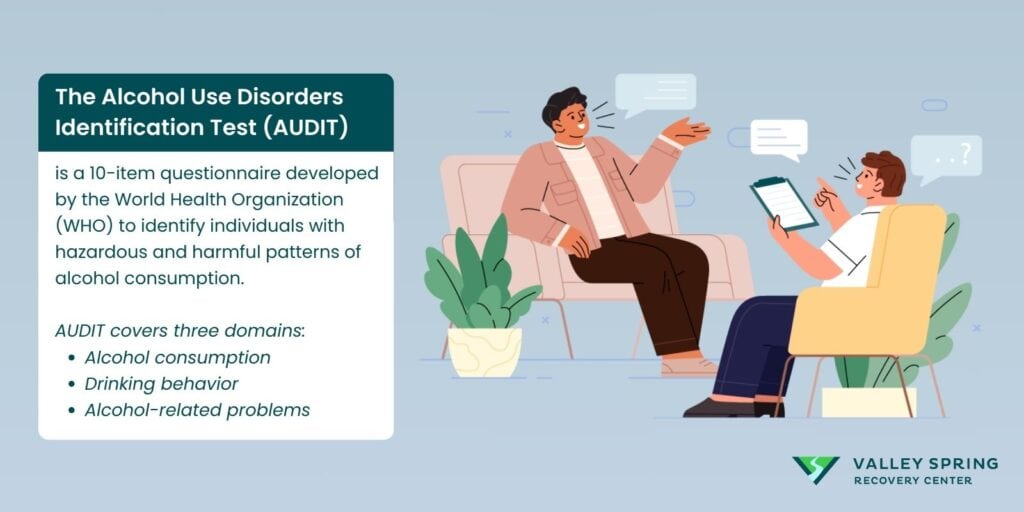
The Alcohol Use Disorders Identification Test (AUDIT) is a 10-item questionnaire developed by the World Health Organization (WHO) to identify individuals with hazardous and harmful patterns of alcohol consumption.
- AUDIT covers three domains: alcohol consumption.
- Drinking behavior.
- Alcohol-related problems.
It is designed to screen for excessive drinking and to assist in brief assessment. A 2021 research by WHO titled “Alcohol Use Disorders Identification Test (AUDIT)” states that “AUDIT is an effective screening tool for identifying people with alcohol use disorders.”
Each question is scored from 0 to 4, with a maximum possible score of 40. A score of 8 or more indicates harmful drinking behavior that warrants further evaluation. The World Health Organization highlights that “A score of 8 or more on the AUDIT suggests hazardous or harmful drinking behavior.”
AUDIT is used globally in various settings, including primary care, emergency rooms, and community health programs, to screen for alcohol misuse and to identify at-risk individuals.”
The advantage of AUDIT is its comprehensive nature, covering various aspects of alcohol use. However, it may be time-consuming to administer in some settings. According to the World Health Organization, while AUDIT provides a thorough assessment, its length may be a limitation in fast-paced environments.”
Rediscover Life at Valley Spring Recovery Center
Get the compassionate support you deserve. We're here to help you reclaim joy, wellness, and a brighter future.
Verify Benefits
6. Drug Abuse Screening Test (DAST)
The Drug Abuse Screening Test (DAST) is a self-report instrument used to identify individuals with drug use problems. It was developed to provide a brief and convenient way to screen for drug abuse.
The DAST consists of 10 questions that focus on drug use and its consequences. It is designed to be administered quickly and can be used in various settings, including healthcare and community programs.
According to Harvey A. Skinner’s 1982 research in the Journal of Substance Abuse, titled “Drug Abuse Screening Test,” the DAST provides a brief, self-report screening tool to assess drug use behavior and its consequences.”
Each question is scored either “yes” or “no,” with “yes” answers indicating drug-related problems. The total score ranges from 0 to 10, with higher scores indicating more severe drug use issues. Harvey A. Skinner also highlights that “A higher DAST score suggests more severe drug use problems that may require intervention.”
The DAST is used in various settings to identify individuals who need further assessment or treatment for drug abuse. It is commonly used in primary care, mental health clinics, and substance abuse treatment programs. The National Institute on Drug Abuse notes that the DAST is widely applied in healthcare settings to screen for drug use disorders.
While the DAST is effective for initial screening, it may provide a partial assessment of all aspects of drug use. It is best used as part of a broader evaluation process. According to Harvey A. Skinner in his research titled “Drug Abuse Screening Test, featured in the “Journal of Substance Abuse in 1982, “The DAST should be supplemented with additional assessments for a complete evaluation of substance use disorders.”
7. Michigan Alcohol Screening Test (MAST)
The Michigan Alcohol Screening Test (MAST) is one of the oldest and most widely used alcohol screening tests. It was developed to screen for alcohol dependence. MAST consists of 25 questions that assess the presence and severity of alcohol use problems.
It is designed to provide a thorough evaluation of drinking behavior and its consequences. Research by Selzer ML, published in the American Journal of Psychiatry in 1971, titled “Michigan Alcohol Screening Test,” states that “The MAST provides a detailed assessment of alcohol use behaviors and their impact.”
Each question is scored based on the severity of the response, with higher scores indicating more severe alcohol use problems. A score of 6 or more suggests the presence of an alcohol use disorder. Selzer ML highlights in his 1971 research called “Michigan Alcohol Screening Test,” published by the American Journal of Psychiatry, that “A score of 6 or more on the MAST indicates a significant likelihood of alcohol dependence.”
The MAST is used in various settings, including medical, psychological, and substance abuse treatment facilities, to identify individuals with alcohol use disorders. The advantage of MAST is its comprehensive nature, covering multiple aspects of alcohol use. However, its length may be a limitation in settings where time is a constraint.
8. CAGE Questionnaire
The CAGE Questionnaire is a brief screening tool for identifying potential problems with alcohol. It consists of four simple questions. CAGE stands for the four questions:
- C: Have you ever felt you should Cut down on your drinking?
- A: Have people Annoyed you by criticizing your drinking?
- G: Have you ever felt bad or Guilty about your drinking?
- E: Have you ever had a drink first thing in the morning (Eye-opener) to steady your nerves or get rid of a hangover?
“Appropriate Use of Drug Testing in Clinical Medicine” by Paul J. Fudala et al., in the Journal of Addiction Medicine, 2017, states that “The CAGE Questionnaire is a quick and effective screening tool for identifying potential alcohol problems.”
Each “yes” answer scores one point. A total score of two or more suggests the presence of an alcohol use disorder. “Appropriate Use of Drug Testing in Clinical Medicine” by Paul J. Fudala et al., in the Journal of Addiction Medicine, 2017, also highlights that “A score of two or more on the CAGE Questionnaire indicates a high likelihood of alcohol dependence.”
The CAGE Questionnaire is used in various settings, including primary care, mental health clinics, and emergency departments, to screen for alcohol problems quickly. According to Paul J. Fudala and colleagues’ research, “Appropriate Use of Drug Testing in Clinical Medicine” in the Journal of Addiction Medicine, 2017, “The CAGE Questionnaire is widely used in clinical settings due to its simplicity and effectiveness.”
The CAGE Questionnaire’s advantage is its brevity and ease of use, making it suitable for quick screening. However, it may not capture all aspects of alcohol use. While the CAGE Questionnaire is effective for initial screening, it may need to be supplemented with more detailed assessments for a comprehensive evaluation.
Are you covered for treatment?
Valley Spring Recovery Center is an approved provider for Blue Cross Blue Shield and Cigna, while also accepting many other major insurance carriers.
Check Coverage Now!9. Alcohol, Smoking, And Substance Involvement Screening Test (Assist)
The Alcohol, Smoking, and Substance Involvement Screening Test (ASSIST) is a screening tool developed by the World Health Organization (WHO) to detect and manage substance use and related problems.
ASSIST includes questions about tobacco, alcohol, and other drugs, assessing the frequency and impact of substance use on the individual’s life. The “Alcohol, Smoking and Substance Involvement Screening Test” by WHO, 2010, states that “ASSIST is designed to assess the use of various substances and the associated risks.”
ASSIST is used in primary care settings, community health programs, and specialized addiction treatment centers to identify individuals who need intervention or treatment for substance use disorders. WHO notes that “The application of ASSIST in healthcare settings enhances the identification and management of substance use disorders.”
The benefits of ASSIST include its comprehensive approach to screening for multiple substances and its ability to guide intervention strategies based on the level of risk. It provides a thorough assessment that guides appropriate interventions for substance use disorders.”
10. Saliva (Oral Fluid) Drug Test
A saliva (oral fluid) drug test is a non-invasive screening method that detects recent drug use by analyzing saliva samples. Saliva drug tests are easy to administer, provide quick results, and can detect the presence of drugs used within the past 24-48 hours.
According to Paul J. Fudala and colleagues in their study titled “Appropriate Use of Drug Testing in Clinical Medicine,” published in the Journal of Addiction Medicine in 2017, “Saliva drug tests offer a non-invasive and rapid method for detecting recent drug use.”
Saliva drug tests are commonly utilized in workplace drug testing, roadside testing by law enforcement, and clinical settings to monitor compliance with drug treatment programs. Paul J. Fudala et al., in their research “Appropriate Use of Drug Testing in Clinical Medicine” 2017, also note that “Saliva drug tests are widely used in various settings due to their ease of administration and rapid results.”
The benefits of saliva drug tests include their non-invasive nature, quick turnaround time, and ability to detect recent drug use, making them suitable for monitoring and compliance purposes. Saliva drug tests provide a fast and non-invasive method for detecting recent drug use, making them useful in both clinical and non-clinical settings.”
The limitation of saliva drug tests is their relatively short detection window compared to other testing methods like urine or hair tests. Paul J. Fudala et al., 2017, “Appropriate Use of Drug Testing in Clinical Medicine” Journal of Addiction Medicine, mentions that “While effective for detecting recent drug use, saliva drug tests have a shorter detection window compared to other methods.”
11. SASSI (Substance Abuse Subtle Screening Inventory)
The Substance Abuse Subtle Screening Inventory (SASSI) is a psychological screening tool used to identify individuals with a high probability of having a drug addiction. The SASSI consists of both overt and subtle items that assess substance use and related behaviors.
It is designed to identify individuals who are in denial about their substance use. “Appropriate Use of Drug Testing in Clinical Medicine” by Paul J. Fudala et al., published in the Journal of Addiction Medicine in 2017, states that the SASSI uses subtle items to detect substance use disorders, even when individuals may be unwilling to disclose their use.
SASSI is used in various settings, including clinical, legal, and educational environments, to screen for substance use disorders. The advantage of SASSI is its ability to detect substance use disorders even when individuals are not fully disclosing their use.
However, its reliance on self-reporting may still be a limitation. According to Paul J. Fudala et al., “Appropriate Use of Drug Testing in Clinical Medicine” in the Journal of Addiction Medicine, 2017, “SASSI’s subtle screening approach is effective, but it still relies on the honesty of respondents to some extent.”
Did you know most health insurance plans cover substance use disorder treatment? Check your coverage online now.
12. Posit (Problem Oriented Screening Instrument For Teenagers)
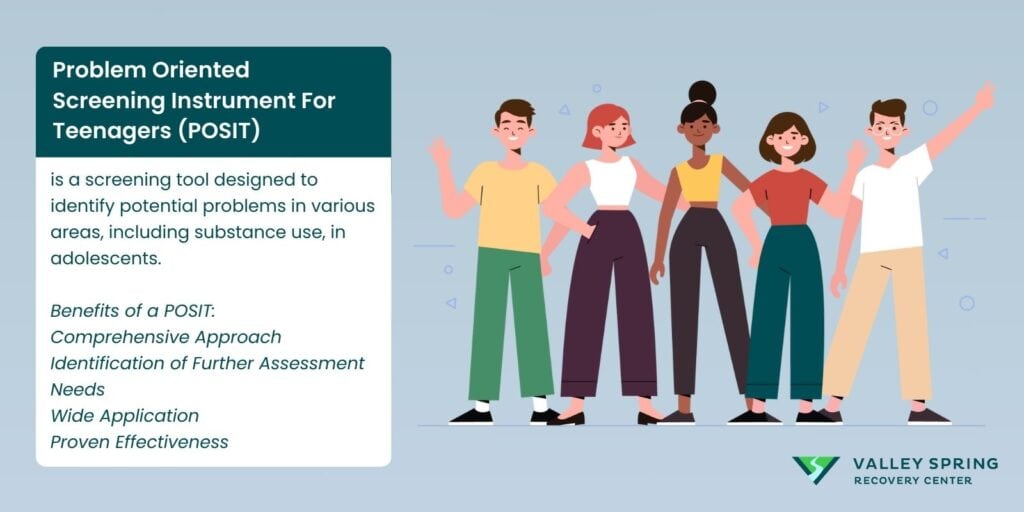
The Problem-Oriented Screening Instrument for Teenagers (POSIT) is a screening tool designed to identify potential problems in various areas, including substance use, in adolescents.
POSIT covers ten functional areas, including substance use, mental health, family relationships, and educational status. It is used to identify teenagers who may need further assessment or intervention. A 1991 research by the National Institute on Drug Abuse titled “Problem Oriented Screening Instrument for Teenagers” states that “POSIT is designed to identify potential problems in multiple functional areas among adolescents.”
POSIT is used in schools, juvenile justice systems, and healthcare settings to screen adolescents for various issues, including substance use and other problems among teenagers.” The advantage of POSIT is its comprehensive approach, covering multiple areas of adolescent life. However, its length may be a limitation in some settings.
13. SDS (Severity Of Dependence Scale)
The Severity of Dependence Scale (SDS) is a brief screening tool used to assess the severity of dependence on various substances. SDS consists of five items that measure the psychological components of dependence.
It is used to evaluate the severity of substance dependence in individuals. Gossop and colleague, in their 1995 research titled “Severity of Dependence Scale” by Addiction, highlight that “The SDS assesses the psychological aspects of substance dependence through a brief, five-item questionnaire.”
SDS is used in clinical and research settings to measure the severity of dependence on substances such as alcohol, cannabis, and opioids. The advantage of SDS is its brevity and focus on psychological dependence. However, it may not capture all dimensions of dependence. It may need to be supplemented with other measures for a comprehensive evaluation.”
14. ASI (Addiction Severity Index)
The Addiction Severity Index (ASI) is a comprehensive assessment tool used to evaluate multiple aspects of addiction, including medical, employment, legal, and family/social status. ASI covers seven domains:
- medical status
- employment/support
- alcohol use
- drug use
- legal status
- family/social status
- psychiatric status.
It is used to identify the severity of addiction and related issues. According to McLellan et al. “Addiction Severity Index” 1985 study, published by the Journal of Substance Abuse Treatment, “The ASI provides a comprehensive assessment of addiction and related problems across multiple domains.”
ASI is used in substance abuse treatment programs, research, and clinical practice to evaluate individuals with substance use disorders. It is widely used in clinical and research settings to assess the severity of addiction and related issues.”
The advantage of ASI is its comprehensive nature, covering multiple areas of an individual’s life. However, its length and complexity may be a limitation in some settings. While the ASI provides a thorough assessment, its length and complexity can be challenging in some environments.
Contact us today to schedule an initial assessment or to learn more about our services. Whether you are seeking intensive outpatient care or simply need guidance on your drug addiction journey, we are here to help.
15. SUDDS (Substance Use Disorder Diagnostic Schedule)
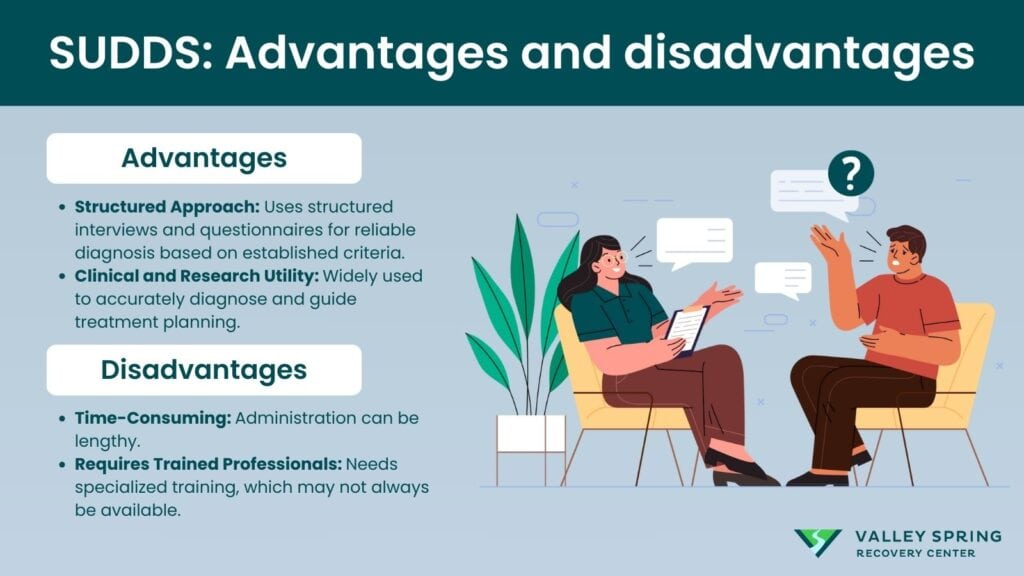
The Substance Use Disorder Diagnostic Schedule (SUDDS) is a diagnostic tool used to identify and evaluate substance use disorders. SUDDS consists of structured interviews and questionnaires that assess the criteria for substance use disorders based on diagnostic manuals such as the DSM.
“Substance Use Disorder Diagnostic Schedule” by the National Institute on Drug Abuse (NIDA), 1991, states that “SUDDS uses structured interviews and questionnaires to diagnose substance use disorders based on established criteria.”
SUDDS is used in clinical and research settings to diagnose substance use disorders and to guide treatment planning. “Substance Use Disorder Diagnostic Schedule” by NIDA, 1991, notes that “SUDDS is widely used in clinical practice and research to diagnose substance use disorders accurately.”
The advantage of SUDDS is its structured approach, which provides a reliable diagnosis. However, it may be time-consuming and require trained professionals to administer. The Substance Use Disorder Diagnostic Schedule by NIDA, 1991, mentions that “SUDDS provides a reliable diagnosis, but its administration can be time-consuming and requires specialized training.”
Where Can I Get A Drug Addiction Screening Test?
Drug addiction screening tests are available in various healthcare settings, including primary care offices, hospitals, mental health clinics, and community health centers. Many online resources and telehealth services also offer screening tests.
“NIDA Screening Tools & Resources” by the National Institute on Drug Abuse, 2023, highlights that “Drug addiction screening tests can be accessed in numerous healthcare settings and through online platforms, making them widely available to those in need.”
How Accurate Are Drug Addiction Screening Tests?
The accuracy of drug addiction screening tests varies depending on the specific test used and how it is administered. Generally, these tests are reliable for identifying individuals who need further evaluation.
However, no test is 100% accurate, and false positives or negatives can occur. “Appropriate Use of Drug Testing in Clinical Medicine” by Paul J. Fudala et al., published in the Journal of Addiction Medicine in 2017, highlights that “While drug addiction screening tests are generally accurate, they are not infallible and should be used as part of a broader diagnostic process.”
Rediscover Life at Valley Spring Recovery Center
Get the compassionate support you deserve. We're here to help you reclaim joy, wellness, and a brighter future.
Verify Benefits
What Happens After A Positive Screening Result?
After a positive screening result, individuals are typically referred for a comprehensive assessment to confirm the diagnosis and determine the severity of the substance use disorder. They will then be directed to appropriate addiction treatment options based on the assessment.
How Do Screening Results Influence Treatment Plans?
Screening results help healthcare providers identify the severity and specific needs of an individual’s substance use disorder, guiding the development of personalized treatment plans that address their unique situation.
What Resources Are Available For Those Who Screen Positive?
Resources for those who screen positive include addiction treatment centers, counseling services, support groups, and rehabilitation programs. Many healthcare providers also offer referrals to specialized services.
Are you covered for treatment?
Valley Spring Recovery Center is an approved provider for Blue Cross Blue Shield and Cigna, while also accepting many other major insurance carriers.
Check Coverage Now!How Is Drug Addiction Screening Adapted For Adolescents?
Screening for adolescents typically involves tools designed to be age-appropriate, such as the CRAFFT screening test, which considers the unique behavioral patterns and risks associated with adolescent substance use.
What Are The Considerations For Screening In Pregnant Women?
Screening in pregnant women involves additional considerations to ensure the safety of both the mother and the unborn child. Healthcare providers use specific tools and approaches to address the potential impacts of substance use during pregnancy.
How Do Mental Health Conditions Impact Drug Addiction Screening Tests?
Mental health conditions complicate drug addiction screening, as symptoms of mental illness may overlap with or mask substance use issues. Integrated screening approaches that assess both mental health and substance use are often used.
Did you know most health insurance plans cover substance use disorder treatment? Check your coverage online now.
What Research Supports The Use Of These Tools?
Research supporting the use of these tools includes studies demonstrating their reliability and validity in identifying substance use disorders and improving treatment outcomes, such as those conducted by the National Institute on Drug Abuse (NIDA) and other health organizations.
Are There Any Limitations Of Drug Addiction Screening Tests?
Limitations and criticisms of these screening tests include potential biases, the risk of false positives or negatives, and the need for supplemental assessments to provide a comprehensive evaluation of substance use disorders.
How Are These Tests Typically Administered (Self-Report Vs. Interviewer-Administered)?
Depending on the setting and the specific tool being used, these tests can be administered Either as self-report questionnaires or by an interviewer. Self-report methods are convenient, while interviewer-administered tests may provide more accurate information.
Contact us today to schedule an initial assessment or to learn more about our services. Whether you are seeking intensive outpatient care or simply need guidance on your drug addiction journey, we are here to help.
In what settings are these drug addiction screening tools used
These screening tools are used in various settings, including primary care offices, mental health clinics, hospitals, community health centers, and specialized addiction treatment facilities.
How Do Healthcare Providers Decide Which Test To Use?
Healthcare providers choose screening tests based on factors such as the population being screened, the specific substances of concern, the setting, and the resources available. They may also consider the test’s validity, reliability, and ease of use.
Share This Post


